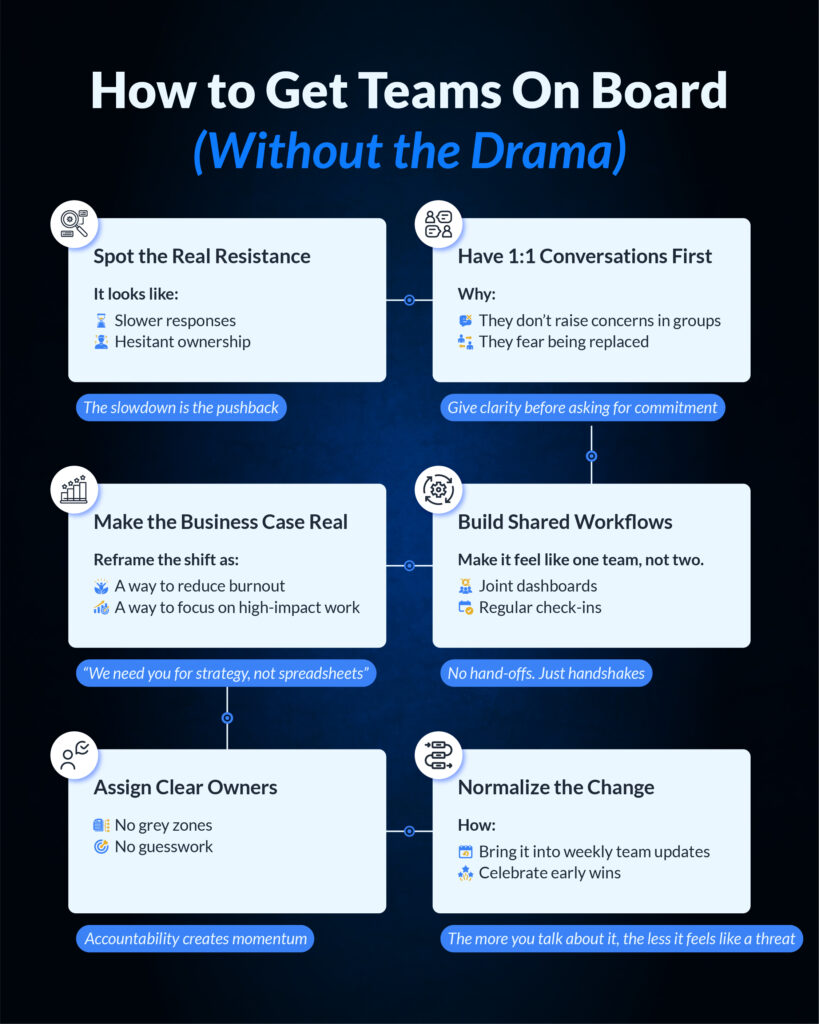Here’s what nobody tells you when you’re scaling a media team. It’s not the strategy that burns you out; it’s the execution.
It happens when your best people are buried under the pressure of reporting templates, fixing tracking errors, or handling last-minute QA. Everyone’s stretched thin, nobody is thinking long-term, and your execution pipeline starts buckling even under basic volume.
Interestingly, instead of fixing what’s broken, most teams simply throw more internal resources at it. They hire, they patch, and they double down on these inefficiencies. But the real fix is knowing when to outsource. It’s before the system breaks, not after. Each time, it begins in the same way: execution gets ignored until it’s too late. By that point, your business has already missed out on not just the cost savings, but on the scale, speed, and stability that outsourcing offers when done right.
The Real Bottleneck
Execution is undervalued because it’s often perceived as the easy part. You simply follow a checklist and hit ‘go.’ But anyone who has worked in the trenches knows that getting campaigns live accurately, on time, and at scale is anything but simple.
More importantly, it’s invisible when it works but glaring when it doesn’t. And yet, it’s rarely given the same strategic attention as planning, creative, or analytics. Leadership often (rightfully) focuses on big-picture goals like profitability, growth, and retention without always being attuned to how clunky the delivery engine has become.
Execution is also under-resourced. In many organizations, senior people are forced to step in and ‘work down’ to compensate for broken processes or inadequate support. Think about it: how often do you see VPs trafficking placements or manually compiling reports just to get a campaign out the door?
The cost of these missteps can be significant. First, you lose speed. Work slows down because your smartest people are stuck firefighting. Then goes quality. QA errors, misfired campaigns, and missed revenue become common. And finally, there’s the opportunity cost. Every hour a senior planner spends debugging tags is an hour they’re not spending on growth strategy or innovation.
Beyond Cost Savings
On average, outsourcing saves businesses around 25% of costs. However, it is not merely a way to save money. The reality is far more compelling.
Engaging specialists for campaign execution can unlock strategic bandwidth. When you offload campaign routine tasks, your internal teams suddenly have the time and the headroom to do what they were actually hired for. In-house professionals may worry about being replaced, but when done right, outsourcing doesn’t replace your team; it amplifies it.
Plus, there’s a hidden advantage. External teams working across multiple clients often see patterns that internal teams cannot. Most in-house teams operate in silos: by clients, campaigns, or managers. This fragmented view makes it nearly impossible to zoom out and understand operational health at scale. A good outsourcing partner can give you that macro view because they work across workflows, not just accounts.
What Should You Offload (And What to Keep In-House)?
There’s a simple yet actionable solution to this dilemma. You need to break it down into two core layers:
- The Execution Layer: This includes campaign setups, ad ops, QA, tagging, trafficking, reporting, and maintenance.
- The Strategic Layer: Here’s where planning, insights, optimization, and media innovation come into the picture.
Clients pay for strategy, but they understandably expect flawless execution. Ironically, it’s when the execution fails that clients leave agencies for their competitors, even if the strategy is sound. That’s why smart businesses are choosing to prioritize strategy in-house while offloading the execution to partners like Atidiv who specialize in scale and precision.
Already, 54% of small businesses are expected to outsource at least one core function by 2025. They know that strong strategy means little if execution can’t catch up, and keeping both in-house is no longer sustainable.
How to Choose (and Use) the Right Partner?
If you’re going to offload campaign execution, it’s crucial to choose your outsourcing partner wisely. Prioritize the following traits in your choice:
- A Strong Focus on the Outcome: Partners must be laser-focused on business outcomes, and not merely on completing a set of tasks.
- A Quick and Process-Driven Approach: Speed is only useful if it’s repeatable. So, look for tight SLAs and clarity in the process.
- Cultural Alignment: Check if the partner you choose gets your tone, tempo, and tolerance for risk.
Once you find the ideal outsourcing partner for your media execution, it’s crucial to structure the relationship intentionally. At Atidiv, we recommend some best practices that can help you do this:
- Build shared dashboards to maintain transparency.
- Set SLAs that reflect the real needs of your business.
- Create feedback loops that are proactive, not reactive.
- Ask the right questions, like where your team is struggling and what needs to be fixed.
- Most importantly, think in workflows, not tasks.
How to Get Internal Teams on Board Without All the Us-vs-Them Drama

Change is hard, particularly when teams fear they may be replaced. However, most resistance doesn’t manifest as outright refusal. It shows up subtly, in hesitation during meetings, dropped ownership, and passive slowdowns. The sooner you recognize these signals, the earlier they can be addressed.
This leads us to the question: How do you tackle such resistance?
The answer lies in involving your teams in the change rather than merely announcing it.
Have 1:1 conversations. Explain the business case behind the decision to outsource. Make it clear that this move isn’t about cost-cutting; it’s about building capacity and unlocking growth. Tying the decision back to individual goals further helps make the move relevant to each person’s role.
It’s also important to make participation non-negotiable. Assign owners to workflows, build shared accountability, and monitor engagement closely. Talk about it in team meetings and normalize the shift by making it a team-wide mandate, not an experiment on the sidelines.
From Short-Term Relief to Long-Term Advantage
When structured right, outsourcing campaign execution becomes a differentiator. You gain institutional speed. You get a second set of eyes on every campaign. You build agility and become capable of flexing up or down as the demand changes.
The longer teams treat execution as something to ‘manage internally but later,’ the more they miss out on the opportunity to get ahead now. It helps to remember that the best campaign execution engine is the one you don’t notice because it runs quickly, smoothly, and at scale. That’s what outsourcing can deliver.
